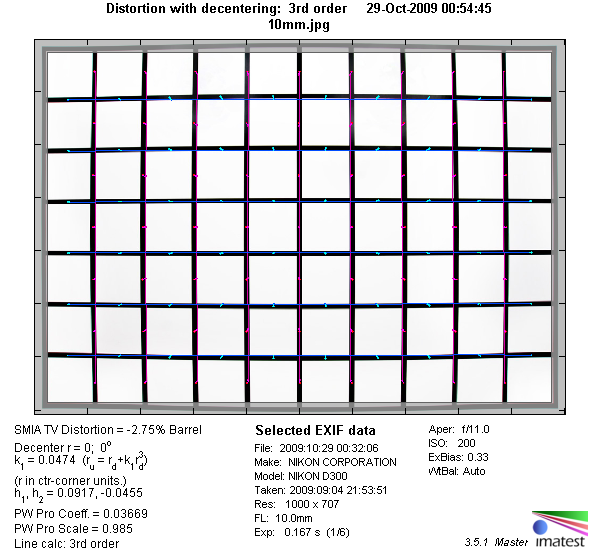|
Sigma AF 10-20mm f/3.5 EX DC HSM - Review / Test Report - Analysis |
|
Lens Reviews -
Nikon / Nikkor (APS-C)
|
|
Page 2 of 3

Distortion
Typical for most ultra wide angle zoom lenses the Sigma shows a fairly large amount of barrel distortion. The situation eases considerably towards longer focal lengths. At 15 mm the lens is basically free of distortion, even the 0.5% pincushion distortion at 20 mm are not really field relevant for most subjects.
|
Move the mouse cursor over the focal length text marks below to observe the respective distortion
|
| 10mm |
15mm |
20mm |
|

|
The chart above has a real-world size of about 120x80cm.
Vignetting
As most other APS-C ultra wide lenses, the Sigma shows a fair amount of vignetting wide open, a little more than one stop at 10 mm and 3/4 of a stop at longer focal lengths. Stopped down vignetting is reduced to half a stop for most focal lengths and apertures (even a little less at 20 mm). This may be noticeable in critical scenes, however for most subjects its probably not field relevant (and even then not too difficult to correct in post processing).

MTF (resolution)
The lens produces excellent center resolution figures at all tested apertures and focal lengths. The border resolution follows only slightly behind and is at least very good, stopped down even excellent at 15 and 20 mm.
Unfortunately the extreme corners cannot match the otherwise excellent performance. At 10 mm wide open, there's hardly more than a mushy blur, even stopping down does not help to lift the resolution to good figures. Fortunately things look much better at 15 mm, where the corners show very good resolution at all tested apertures, and also at 20 mm, where the corners wide open are only good, but very good one stop down.
Please note that the MTF results are not directly comparable across the different systems!
Below is a simplified summary of the formal findings. The chart shows line widths per picture height (LW/PH) which can be taken as a measure for sharpness.
If you want to know more about the MTF50 figures you may check out the corresponding Imatest Explanations
Chromatic Aberrations (CAs)
At 10 mm the lens showes a more or less constant amount of CAs (color shadows at harsh contrast transitions), well above 1 pixel in size at all tested apertures. At 15 mm the total amount is a little lower wide open, but increases when the lens is stopped down. At 20 mm, CAs are less of an issue with values below 1 pixel.
CAs can easily be removed in post processing, and some of the newer Nikon DSLRs already do this in camera (if you shoot JPG).

|